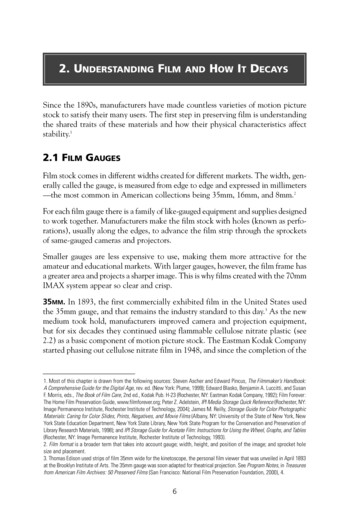
Transcription
2. UNDERSTANDING FILMANDHOW IT DECAYSSince the 1890s, manufacturers have made countless varieties of motion picturestock to satisfy their many users. The first step in preserving film is understandingthe shared traits of these materials and how their physical characteristics affectstability.12.1 FILM GAUGESFilm stock comes in different widths created for different markets. The width, generally called the gauge, is measured from edge to edge and expressed in millimeters—the most common in American collections being 35mm, 16mm, and 8mm.2For each film gauge there is a family of like-gauged equipment and supplies designedto work together. Manufacturers make the film stock with holes (known as perforations), usually along the edges, to advance the film strip through the sprocketsof same-gauged cameras and projectors.Smaller gauges are less expensive to use, making them more attractive for theamateur and educational markets. With larger gauges, however, the film frame hasa greater area and projects a sharper image. This is why films created with the 70mmIMAX system appear so clear and crisp.35MM. In 1893, the first commercially exhibited film in the United States usedthe 35mm gauge, and that remains the industry standard to this day.3 As the newmedium took hold, manufacturers improved camera and projection equipment,but for six decades they continued using flammable cellulose nitrate plastic (see2.2) as a basic component of motion picture stock. The Eastman Kodak Companystarted phasing out cellulose nitrate film in 1948, and since the completion of the1. Most of this chapter is drawn from the following sources: Steven Ascher and Edward Pincus, The Filmmaker’s Handbook:A Comprehensive Guide for the Digital Age, rev. ed. (New York: Plume, 1999); Edward Blasko, Benjamin A. Luccitti, and SusanF. Morris, eds., The Book of Film Care, 2nd ed., Kodak Pub. H-23 (Rochester, NY: Eastman Kodak Company, 1992); Film Forever:The Home Film Preservation Guide, www.filmforever.org; Peter Z. Adelstein, IPI Media Storage Quick Reference (Rochester, NY:Image Permanence Institute, Rochester Institute of Technology, 2004); James M. Reilly, Storage Guide for Color PhotographicMaterials: Caring for Color Slides, Prints, Negatives, and Movie Films (Albany, NY: University of the State of New York, NewYork State Education Department, New York State Library, New York State Program for the Conservation and Preservation ofLibrary Research Materials, 1998); and IPI Storage Guide for Acetate Film: Instructions for Using the Wheel, Graphs, and Tables(Rochester, NY: Image Permanence Institute, Rochester Institute of Technology, 1993).2. Film format is a broader term that takes into account gauge; width, height, and position of the image; and sprocket holesize and placement.3. Thomas Edison used strips of film 35mm wide for the kinetoscope, the personal film viewer that was unveiled in April 1893at the Brooklyn Institute of Arts. The 35mm gauge was soon adapted for theatrical projection. See Program Notes, in Treasuresfrom American Film Archives: 50 Preserved Films (San Francisco: National Film Preservation Foundation, 2000), 4.6
Film GaugesFilm comes in different widths, called gauges. The width is measured in millimeters.changeover four years later, no nitrate film of any kind has been manufactured inthe United States.4 With minor exceptions, the expense and hazard of early 35mmlimited the medium to professionals.16MM. The film gauge most frequently found in American archives, libraries, andmuseums is 16mm. Kodak introduced 16mm in 1923 as a safe, nonflammable alternative for the home and educational markets. The cameras and projectors wereportable, lightweight, and easy to operate. Amateurs embraced the new gauge andformed cine clubs where they could show their work and trade technical advice.Corporations adopted 16mm as a convenient gauge for employee training films.Soon an industry developed for producing 16mm instructional and educationalfilms for businesses, schools, churches, and clubs. With the advent of portablevideo equipment in the 1970s, many 16mm users began switching to video. Thus,most 16mm films in archives, libraries, and museums date from the 1920s throughthe early 1980s.REGULAR 8MM AND SUPER 8MM. Another common gauge in repositories is 8mm,often called Regular 8mm, which was introduced by Kodak in 1932 for homemoviemakers. Many 8mm cameras use a spool or magazine containing 16mm filmstock that is perforated with twice as many sprocket holes per foot as normal16mm. When the film is sent to the laboratory for processing, it is slit to createtwo 8mm strips. Thus, 16mm and 8mm film have the same-size sprocket holes.4. Most sources give 1951 as the last year of manufacture. Kodak reports that it began converting to safety film in 1948 andcompletely discontinued nitrate film production in 1952. Nitrate film stock remained in use through the early 1950s. Search“Chronology of Motion Picture Films—1940 to 1959,” at www.kodak.com.7
Understanding Film and How It DecaysSuper 8mm, first sold in 1965, brought an important innovation. It reduced the sizeof the sprocket holes, leaving more area for the picture. Super 8mm is used by amateurs and professionals and has won a following among avant-garde filmmakers.OTHER GAUGES. Many other gauges were tried in the early years of the nontheatrical market. Pathé, for example, introduced 28mm in 1912 and 9.5mm in 1922.Most did not survive the standardization brought largely by Kodak.52.2 INSIDETHEFILM STOCKRegardless of the gauge, all motion picture films have the same basic structure. Filmstock has two primary layers. The thicker layer, the transparent plastic base, provides support. The thinner layer, the emulsion, carries photosensitive materials ina gelatin binder. Both the base and the emulsion are subject to decay.FILM BASES. Over the years manufacturers have used three types of transparentplastic for the film base: first cellulose nitrate, then cellulose acetate, and most recently polyester. Each has its own characteristics.NITRATE.When motion picture film was introduced in the 1890s, cellulose nitratewas the only available transparent plastic durable enough for movie cameras andprojectors. While strong and flexible, nitrate base film has a singular downside: Itis highly flammable. Nitrate fires are virtually impossible to extinguish once theystart burning.6 (See 6.5 on the procedures for storing nitrate film.)The words NITRATE FILM appear along theedge of many Kodak cellulose nitratemotion picture stocks.Most 35mm film stock before the early1950s had a cellulose nitrate base. Because of its flammability, nitrate base filmstock was never used by American manufacturers for 16mm and 8mm film andwas not sold by Kodak to the home market. As a precaution, from the mid 1920son, Kodak labeled many of its nitratestocks with the words NITRATE FILM alongthe edge to distinguish it from the materials intended for hobbyists.5. For a detailed chronology chart breaking out motion picture films by brand name, manufacturer, and film base, see FilmGauges in the glossary of the ScreenSound Australia Web site, www.screensound.gov.au. For more on antique gauges, seePaolo Cherchi Usai, Silent Cinema: An Introduction, rev. ed. (London: BFI Publishing, 2000), and Brian Coe, The History of MoviePhotography (Westfield, NJ: Eastview Editions, 1981).6. Once started, the combustion of nitrate film liberates its own oxygen and is self-sustaining.8
Inside the Film StockTABLE 1. FILM GAUGESANDTHEIR SUPPORT MATERIALSupportDates of UseGaugeNitrate1893–early 1950s35mmAcetate1909–present*35mm, 28mm, 16mm, 9.5mm, Regular 8mm,Super 8mmPolyesterMid 1950s–present35mm, 16mm, some Super 8mm*Cellulose diacetate motion picture film is thought to have been introduced in 1909. The first extant example dates from 1912.Diacetate was followed in the 1930s by cellulose acetate propionate and cellulose acetate butyrate, and in the late 1940s bycellulose triacetate.ACETATE. Manufacturers found a safe substitute for cellulose nitrate by exploringplastics in the cellulose acetate family. Beginning in 1909, a number of new acetatebases were introduced, starting with cellulose diacetate,7 then in the 1930s cellulose acetate propionate and cellulose acetate butyrate, and finally in the late 1940scellulose triacetate.8 Generally speaking, all relatively nonflammable substitutesfor nitrate are called safety film. Every known American 16mm and 8mm film employs some type of safety film base. Kodak acetate film often has the words SAFETYFILM printed along the edge.POLYESTER. In the mid 1950s, Kodak began selling a new type of safety film madeof polyester. Polyester is the toughest and most chemically stable film base usedtoday. Because it is so strong, polyester can be made thinner than other types ofmotion picture stock. In addition, its tensile strength makes it less vulnerable tophysical damage caused by improper handling. Polyester is the film stock now generally used for new 35mm release prints shown in American theaters. Unlike nitrateor acetate film, polyester cannot be spliced with currently available film cement.It can, however, be spliced with splicing tape or an ultrasonic splicer.Under similar storage conditions, polyester far outlasts other types of film. Polyesteris sold under various trade names, such as Cronar (Dupont) and ESTAR (Kodak).EMULSION. The emulsion carries the photosensitive materials in a gelatin binder,forming the image-creating layer. The composition of this layer differs for blackand-white and color films.The emulsion of raw black-and-white motion picture film contains silver saltsthat are converted to metallic silver particles during processing. With black-and-7. For a discussion of 28mm diacetate film, see Anke Mebold and Charles Tepperman, “Resurrecting the Lost History of28mm Film in North America,” Film History 15 (2003): 137–51.8. Each brought a technical improvement: Cellulose acetate propionate and cellulose acetate butyrate overcame the physical weakness of cellulose diacetate but were not as strong as cellulose triacetate.9
Understanding Film and How It Decayswhite stock, the emulsion side of the filmappears duller and more textured thanthe shiny and smoother base side. Whenproperly processed and stored, silver images are very stable.EmulsionGelatin binderSilver particleBaseThe emulsion of color motion pictureCross section of black-and-white film.film, on the other hand, contains threelayers of dyes—yellow, cyan, and magenta. The emulsion and base sides are difficult to distinguish, but it is possible toidentify the emulsion side by holding the film to the light and checking for theside on which the image appears slightly raised or textured.2.3 NEGATIVE, PRINT,ANDREVERSAL FILMSIn the photographic process that createsmoving pictures, the film element thatA Rollcaptures the image in the camera is theShot 1LeaderShot 3negative. The negative is developed andprinted to make a positive for projecB Rolltion. Sometimes two rolls of negative orLeaderShot 2Leaderpositive—A and B rolls—are run in succession through the printer, allowing the16mm A and B rolls, the shots are dividfilmmaker to alternate between them to Withed between two rolls of film and separatedhide the splices between scenes and to by leader.create fades and dissolves. Where onecarries the picture, the other has black or blank leader. Collections acquired fromfilmmakers and film-producing organizations may have 16mm negatives or positives in the form of A and B rolls.Reversal film is a special case. The same film that runs through the camera isprocessed to become a positive image. Thus, with reversal film, the camera original can become the projection print without use of an intervening negative.Often cost-conscious amateur and independent filmmakers favor reversal film.Because it shortcuts the traditional negative-positive printing process, reversalstock is cheaper to use. Reversal film maybe color or black and white.In a reversal original (left), the film edge isblack; in a print made from a negative, theedge is usually clear.A good portion of the 16mm and virtually all Regular 8mm and Super 8mm prints10
Color in Filmfound in American collections are reversal originals. They can be identified byexamining the film edge near the sprocket holes. If the edge appears clear, theprint was produced from a negative; ifblack, it is probably reversal film.2.4 COLORINFILMWhile the first exhibited films were inblack and white, filmmakers soon foundways to add color to their works. Duringthe early years of the motion picture,color was sometimes painted on printsby hand, often with a stencil. The morecommon technique in the United Stateswas to dye black-and-white prints withtints. Though tinting was largely confined to 35mm commercial releases,Kodak added amber and occasionallyother colors to 16mm prints of theatricalfilms that were sold to consumers overthe-counter. These are found today insome collections.LENTICULAR FILM: BLACKWHITE OR “COLOR”?ANDBefore introducing Kodachrome,Kodak sold an unusual type of16mm black-and-white film thatprojects as a color image whenshown through a customized projector with a three-color lens. Thefilm base is embossed lengthwisewith ridges, called lenticules, thatact as semicylindrical lenses. Whenlight is projected through theselenticules and the three-colorprojector lens, a color image iscreated on the screen.It is easy to mistake lenticularcolor film for black and white.For identification, first check forthe word KODACOLOR printed on thefilm edge (see 3.3 on edge codes).Then examine the base side of thefilm under magnification, and lookfor raised cylindrical bands runningparallel to the film edge.Specialist laboratories can verifyidentification and make moderncolor copies from lenticular prints.*Experiments in capturing natural colorwith the camera led to the development*See the Film Technology Company Inc. Web site,www.filmtech.com.of various color film stocks and printingprocesses in the 1920s and 1930s for thelucrative 35mm commercial market. The remarkably stable Technicolor printsgained primacy in the late 1930s, but cheaper, more convenient systems eventually won out.For amateurs, Kodak introduced the celebrated Kodachrome reversal film in 1935.While the film stock was initially prone to fading, Kodak made improvementsand by 1938 had a film with notable stability. With 16mm and 8mm Kodachrome,color can remain vivid decades later, particularly if the film has been stored undercold and dry conditions.After World War II, other brands of color film reached the 16mm and 8mm market, each with its own characteristics. Manufacturers have significantly improvedthe stability of photographic dyes, but fading is still a major preservation problemwith older color films.11
Understanding Film and How It DecaysComposite prints (from left): 16mm print with magnetic sound track and balance stripe, 35mm printwith variable area optical sound track, and 35mm print with variable density optical sound track.2.5 SOUND TRACKSEarly innovators strove to integrate sound, like color, in the motion picture viewing experience. Hollywood had converted to sound by 1929. The high-end amateurmarket followed, with RCA introducing the first 16mm sound camera in 1934.Sound tracks can be found on 35mm, 16mm, Super 8mm, and occasionally 8mmprints. A viewing positive with a sound track is called a composite print.Before the advent of digital technology, sound tracks came in two types: opticaland magnetic. Most optical tracks are photographically exposed directly onto thefilm during printing. In projection, light passing through the track is read andtranslated as sound. Optical tracks appear along the edge of the film as eitherhigh-contrast wavy lines (variable area) or a gray stripe of varying darkness (variable density).Magnetic tracks, or mag tracks, work on a different principle from optical tracks.The mag track operates like a magnetic audiotape affixed to the film. During projection the track is read by the projector’s playback head. Mag tracks appear as adull brown stripe, usually along the edge of the film’s base side. Particularly onsmall gauge films, a second stripe is often added along the opposite film edge forphysical balance; with a stripe along both edges, the film produces a more evenroll when wound. This balance stripe may be used to carry a second audio track.Sound tracks usually precede their matching images on the motion picture film.This offset is necessary so that the projector reads the sound at a point in the filmpath at which the movement is smooth and steady.9 The separation between soundand picture varies with format, as shown in table 2. It is important to rememberthis principle when making film repairs (see 3.5) so that sound is not lost.In commercial filmmaking, before sound is added to the print it is often stored asa separate film element, tape, or electronic file. Collections acquired from film9. Film moves intermittently through the projection gate, where image projection occurs, so the sound track must be readeither before or after the film passes through this gate.12
Common Types of Decay and DamageTABLE 2. NUMBEROFFRAMES USUALLY SEPARATING SOUNDAND IMAGE35mm*16mm8mmSuper 8mmMagnetic track28285618Optical track2026Not used22* 35mm mag and some early 35mm optical tracks follow the picture instead of preceding it.makers and film-producing organizations may include 35mm or 16mm mag filmsused in production. These elements, sometimes called full-coat mags, have a dullbrown magnetic recording layer covering one side of the film surface. Similarly,filmmakers and preservationists may put the optical sound track on separate trackonly reels.10 With amateur and avant-garde films in particular, preservationistsshould watch for commentary, dialogue, or music recorded on a separate audiotape reel or cassette intended to be played with the film during screening.2.6 COMMON TYPESOFDECAYANDDAMAGEEarly motion pictures were assumed to have little value after their initial commercial release. Film was intended as an exhibition medium.While base and emulsion are both prone to chemical decay, some film stocks orbatches may be more vulnerable than others. Poor storage and handling take afurther toll. The following are common types of film decay and damage found inlibrary, museum, and archive collections.MECHANICAL DAMAGE. When film is mishandled, inevitably there is physical damage. Films unspooled on a dirty worktable or passed through worn rollers can pickup dust, dirt, scratches, and abrasions. Tears can occur if the film is stressed during winding (see 3.2) or projection. When the film is incorrectly threaded in theprojector, perforations can be stretched, ripped, or torn apart. Improper shippingprocedures are another major cause of damage (see 5.8). The physical evidence ofpast abuse remains with the film print.Preservationists can repair tears, damaged splices, and broken sprocket holes. Butscratches are permanent, though they sometimes can be minimized in the laboratory during duplication.MOLD, MILDEW, AND FUNGUS. A film stored under humid conditions can becomea host for mold, mildew, and fungus. Generally the organisms start the attack fromthe outside edge and make their way into the film roll. These biological agentscan cause significant damage to the emulsion.10. With optical track elements, the film area that would ordinarily carry the picture is blank.13
Understanding Film and How It DecaysThe growth initially appears in the formof matte-white spots and eventuallygrows into a lacy, weblike pattern. Theinvasion can be stopped by cleaning thefilm (see 3.6) and then moving it to acold and dry environment. Once theorganisms have eaten into the emulsion,however, the image loss is irreversible.ACETATE DECAY (VINEGAR SYNDROME).Water, high humidity, and heat can destroy the plastic base of acetate film. Inthe early stage of decay the plastic releases acetic acid, which is chemicallyidentical to vinegar, hence the name“vinegar syndrome.” As the decomposition advances, the chemical reactionaccelerates.Typically the decay process follows thispattern:1. The film begins to smell likevinegar.2. The film base begins to shrink.As the base shrinks irregularly,the film resists being laid flat.It curls and warps along bothlength and width.3. The film loses flexibility.4. The emulsion may crack and eventually flake off.5. White powder may appear alongthe edges and surface of the film.The acetic acid vapor released by filmswith vinegar syndrome can infect otheracetate base materials stored nearby,particularly in a poorly ventilated storage area. The Image Permanence Institute (IPI) at the Rochester Institute ofTechnology advises freezing films in advanced acetate decay (A-D Strip level 2or above).14Mold growing on film.As acetate film decays, it shrinks, loses flexibility, curls, and warps.MEASURING ACETATEWITH A-D STRIPSDECAYIPI's A-D Strips are an easy way tocheck for acetate decay. Just put astrip with the film in the can orbox and close the lid. After at least24 hours—exposure time varieswith temperature and relativehumidity—the strip will turn coloron a scale from blue (0, the lowestacidity) to yellow (3, the highest).To assess the overall level ofacetate decay in a film collection,IPI recommends testing a randomsample of materials. Instructionsare found in IPI’s User's Guide forA-D Strips, which can be downloaded from www.rit.edu/ipi.A-D Strips are not designed for usewith nitrate or polyester film.
Common Types of Decay and DamageAcetate decay cannot be reversed, but itcan be slowed by improving storageconditions (see chapter 6). At the earlydecay stages, the film content can berescued by transferring it to new filmstock. Generally once the film becomestoo brittle, it cannot be copied in itsentirety, although less damaged sectionsmay be salvageable.SHRINKAGE. Although shrinkage is amajor symptom of acetate decay, it alsoaffects nitrate and can be aggravated byoverly dry storage conditions. If the relative humidity falls below 15% for extended periods, the film loses moisture,contracts, and may become brittle.USINGA SHRINKAGE GAUGEA shrinkage gauge is a tool formeasuring the degree of shrinkagein motion picture film. As the filmshrinks, the distance between itssprocket holes decreases correspondingly. The instrument appliesthis fact in measuring shrinkage.To obtain a shrinkage reading, layyour film flat along the device andengage the sprocket holes in thetwo pins, one of which is fixed andthe other movable. The instrumentcompares the standardized distancebetween perforations with that ofyour film and expresses the difference in terms of a percentage.Depending on the design, the toolcan be adjusted to accommodatedifferent film gauges. Illustratedinstructions are provided on theAssociation of Moving ImageArchivists (AMIA) Web site,www.amianet.org.Recognizing the diagnostic importance of measuring shrinkage, theAMIA provides a shrinkage-gaugelending service for members.Using a shrinkage gauge.Shrinkage is a particular problem forsmall gauge films because of the smallersize of the film frame and the mechanical precision required of the equipment.Once a 16mm or 8mm film has shrunkbeyond 0.8% (1% for 35mm), it may bedamaged in projection. Beyond 2%,even skilled laboratories can have trouble copying the film. At this point thefilm generally exhibits additional decayproblems beyond shrinkage.ESTIMATING SHRINKAGE:THE LOW-TECH APPROACHWhile not as precise as a shrinkagegauge, another method for estimating shrinkage is to compareyour film against new film stock ofthe same gauge.Take a strip of fresh film 100frames long and line it up with 100frames of test film; if the older filmis one-half a frame shorter, theshrinkage is 0.5%.COLOR FADING. While varying in stability, all types and brands of color motionpicture film will fade over time. The three dye layers lose their original color atdifferent rates. In some film stocks, yellow is the first to go; in others it is cyan. Asdyes break down, the color balance changes. Contrast is lost, and the film begins15
Understanding Film and How It Decaysto acquire a pinkish brown cast. Eventually the film takes on a washed-out monochromatic look. Prints and negatives can experience fading at different rates.Heat and high relative humidity are the main culprits in color fading. The processcan be slowed by cool and dry storage (see chapter 6) but not reversed.For many years motion picture laboratories have sought methods to correct fadedHollywood film. Recently several proprietary photochemical processes have attracted interest. Digital techniques are also gaining ground. But for the presentboth approaches are far beyond the budget of noncommercial film collections.NITRATE DECAY. The best-known form of film deterioration is nitrate decay. Nitratedegradation is a chemical process that occurs because of two factors: the nature ofcellulose nitrate plastic itself and the way that the film is stored.Nitrate decay follows a pattern. The International Federation of Film Archives(FIAF) defines the telltale criteria that distinguish the five-stage process.11 Generally once nitrate film reaches the third stage, it cannot be duplicated. Severelydeteriorated nitrate film is a hazardous waste and should be transferred to an authorized facility for disposal.Like other forms of chemical film decay, nitrate deterioration cannot be reversedbut can be retarded by improving storage (see chapter 6). Nitrate film should becopied before degradation affects the image.FIVESTAGES OF NITRATE DECAY1. Image fading. Brownishdiscoloration of emulsion.Faint noxious odor.2. Sticky emulsion. Faint noxiousodor.3. Emulsion softens and blisterswith gas bubbles. More pungentodor.4. Film congeals into a solid mass.Strong noxious odor.5. Film disintegrates into brownishpowder.Nitrate “blooms” on a film in stagetwo nitrate decay.11. See Eileen Bowser and John Kuiper, eds., A Handbook for Film Archives (New York: Garland Publishing, 1991), 18–19.16
Common Types of Decay and DamageMAGNETIC TRACK DETERIORATION. Preservationists have observed that acetate filmswith magnetic sound tracks are especially vulnerable to vinegar syndrome, leading scientists to speculate that the iron oxide in the magnetic track may act as acatalyst in acetate decay. As the film base shrinks and becomes brittle, it compromises support of the magnetic sound strip. The magnetic coating can shedoxide, become sticky, or completely separate from the base.As with the other chemical decay problems, improved storage slows the process. Toprevent sound loss, it is important to copy the sound as soon as decay is detected.17
Understanding Film and How It DecaysTABLE 3. FILM DAMAGEProblemDetectionMethodANDDECAY: SUMMARYSymptomsRemedyMechanicaldamage(All film gauges)Visual inspection Tears Torn or brokenperforations Broken splicesPhysical repairCarelesshandling(All film gauges)Visual inspection Dirt Scratches andabrasions on thefilm surface Cleaning Scratches can beminimized duringpreservation copyingMold, mildew,and fungus(All film gauges)Visual inspection Matte-white spots onexterior of film roll Growth into lacy,white web Cleaning Improved storageAcetate decay(All acetatebase film) Vinegar odor Shrinkage Loss of flexibility;curling Cracked emulsion White powder onedge A-D Strip levelgreater than 0 Slow by improvingstorage Isolate infectedfilms Copy contentbefore decay istoo advancedColor fadingVisual inspection Shift in color Loss of contrastand color balance Film appearswashed out Slow by improvingstorage Copy contentbefore decay istoo advancedNitrate decay(Not relevantto acetate orpolyester film) Visual inspection Smell Rusty metal cans1. Image fading.Brownish discoloration of emulsion.2. Sticky emulsion.Faint noxious odor.3. Emulsion softens andblisters with gas bubbles. Stronger odor.4. Film congeals insolid mass. Strongnoxious odor.5. Film disintegratesinto brownishpowder. Slow by improvingstorage Copy contentbefore decay istoo advanced Dispose films inadvanced decay ashazardous wasteDecay of magnetic soundtrack onacetate film Film base losesflexibility Mag track sheds,sticks, and separates Vinegar odor A-D Strip levelgreater than 0 Slow by improvingstorage Copy sound assoon as possibleA-D StripsSmellShrinkageVisual inspectionA-D StripsSmellShrinkageVisual inspection18
(Rochester, NY: Image Permanence Institute, Rochester Institute of Technology, 1993). 2. Film formatis a broader term that takes into account gauge; width, height, and position of the image; and sprocket hole size and placement. 3. Thomas Edison used strips of film 35mm wide for the kinetoscope, the personal film viewer that was unveiled in .











